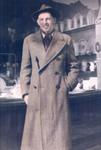Born 1790, Died 1865
Married ?
Frederick Bindemann was born July 31, 1790 in Prussia, the son of August George Bindemann, a Reformed Church pastor. After serving in the Prussian army, Frederick emigrated to America in 1820 and went to Pennsylvania as a missionary of the Union Church of Prussia. He served a number of congregations there as well as preaching in Buffalo, New York. In 1834 he came to the early hamlet of New Hamburg. He was a rugged individual who fitted well into those pioneer days and took the primitive conditions in his stride. In the late 1830s Bindemann came to live in a home that he purchased in the Greenbush (where Grand River Hospital is today). He set out to establish preaching points in the surrounding communities. Among the early churches of the Lutheran persuasion he helped begin were in Preston, New Hamburg and St. Agatha; St. Peters in Heidelberg, St. Johns in Waterloo, and Trinity, St. Pauls, St. Peters and Zion in Berlin. In those days he was called the “marrying parson” because ministers in the 1830s and 40s were in short supply. Bindemann, according to some reports, performed over 2,000 marriages in his home on King St. One of the stories recounted by historian C. W. Wells was about an eloping couple arriving at the pastor’s home closely followed by the bride’s irate father. Bindemann just had time to say “amen” before the father burst in at the door. To the father he said “Ja, sie sind zu spaet” (Yes, you are too late) but I shall marry them over again.” So the couple were married in front of the father who felt he had been too late to stop the proceedings. In the 1840s, some of his parishioners began to feel that that the message they were hearing from the pulpit was different from that in their homeland. Especially new Lutheran pastors coming to these new churches brought Bindemann’s theology into question. Gradually, one after another, the churches he helped begin, turned against him. Bindemann died in 1865 and was buried by Pastor Tuerk, a Swedenborgian, in the First Mennonite cemetery on King St. in Berlin. In spite of his doctrinal differences and other difficulties, he is remembered and respected for his early religious work in the Waterloo area.
Sources:
1. Rev Eric Schultz, Rev. Frederick Bindemann 1790-1865 Waterloo Historical Society, Vol 77, 1989.
2. Marg Powell, Ed Devitt, and Pat McKegney, Welcome to Waterloo
3. Waterloo County Hall of Fame
4. Clayton W Wells, A Historical Sketch of the Town of Waterloo Ontario, Waterloo Historical Society, Vol 14, 1928
5. Waterloo County Churches, Rosemary Willard Ambrose
6. 100th Anniversary St John's Evangelical Lutheran Church
Frederick Bindemann Biography
Description
- Creator
- Little, Ellis, Author
- Media Type
- Text
- Item Type
- Articles
- Description
- This is a handwritten biography of Frederick Bindemann from the Ellis Little Papers. This biography has been transcribed exactly as written. Ellis Little was a local historian, who was the principal of Elizabeth Ziegler Public School. On his retirement, he invested much of his time in researching and writing about Waterloo's history. The Ellis Little Papers consist of extensive notes, papers and historical works.
- Notes
- To see the original document please visit the Ellis Little Local History Room at the Main Branch of the Waterloo Public Library
- Date Of Event
- 1790-1865
- Subject(s)
- Personal Name(s)
- Bindemann, Frederick
- Local identifier
- ELP 51.19 and ELP 63.41.16
- Collection
- Ellis Little Papers: Men and Women of Our Past
- Language of Item
- English
- Copyright Statement
- Uses other than research or private study require the permission of the rightsholder(s). Responsibility for obtaining permissions and for any use rests exclusively with the user.
- Location of Original
- Ellis Little Papers
- Contact
- Waterloo Public LibraryEmail:askus@wpl.ca
Website:
Agency street/mail address:35 Albert Street, Waterloo, Ontario, Canada, N2L 5E2
- Full Text



